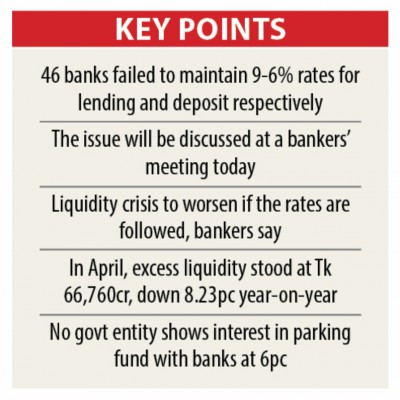BB bent on 9-6pc interest rates
Economists and bankers say dictated interest rates will affect the sector
The central bank is adamant about having 9 percent and 6 percent interest rates respectively for lending and deposits in the banking sector, slapping the 46 errant banks with warning letters recently.
The higher rates are not acceptable given the commitment made by the sponsors of private banks in August last year, the Bangladesh Bank said in the letter on July 8 to 46 banks whose interest rates are well above the specified rates.
In August last year, the managing directors and chairmen of all banks reached a consensus at a meeting with the then finance minister AMA Muhith to set 9 percent and 6 percent interest rates respectively for lending and deposits. As per the decision, the BB had instructed all banks in December last year to implement the new rates. But many did not follow the instruction. Now, the central bank has decided to crack its whip on the banks. The issue will be discussed again today at the quarterly meeting of all banks’ managing directors at the central bank headquarters.
But economists and bankers said the BB’s demand will deteriorate the sector’s financial health.
This time the liquidity crunch in the banking sector is more intense than last year, said Ahsan H Mansur, executive director of Policy Research Institute.
As of April, the excess liquidity in the banking sector stood at Tk 66,760 crore, down 12.60 percent from December last year and 8.23 percent a year earlier, according to data from the central bank.
“The whole banking sector will go up in flames if the central bank tries to set the rates artificially.”
Depositors will shy away from banks if they get returns as low as six percent, he said. Instead, many will park their funds with the capital market or the real estate and some may even turn to money laundering.
Already, savers are opting for government savings tools because of their higher yield in comparison to banks’ deposit products, he said.
The interest rate of the national savings instrument ranges from 11.04 percent to 11.76 percent while banks offer a maximum of 7-8.50 percent.
In June, the interest rates on both lending and deposit of 31 banks exceeded the 9-6 percent bounds, according to data from the central bank.
Some 12 banks failed to offer the 9 percent interest rate on lending, while four banks’ offered more than 6 percent interest for deposits.
Banks will hardly bother to follow the central bank instruction as interest rates are determined by demand and supply, said a managing director of a bank wishing not to be identified.
“There is no scope to disburse loans at 9 percent if banks fail to mobilise deposits at six percent.”
He went on to goad the central bank to issue a blanket, watertight instruction to all banks to follow the 9-6 percent interest rates instead of sending warning letters.
“But the central bank will not do it because it will go against the open market policy. So, the instruction is absurd.”
Asked why lenders would not follow the 9-6 interest rates despite giving their word to the government, he said, “The directors do not run banks — they are not aware of the problems we have to face every day to run the bank.”
The finance ministry had earlier said the state-run corporations would keep their deposits with banks at six percent rate but no one has done so, he said.
Besides, the ministry also decided to deposit 50 percent of the government agencies’ funds with private banks, up from 25 percent previously.
But only a few lenders with strong links with the government have managed the facility, he added.
“We want to lower the interest rate on lending to 9 percent but that totally depends on the rate at which we manage to attract deposits,” said Syed Mahbubur Rahman, chairman of the Association of Bankers, Bangladesh, a platform of the private banks’ managing directors.
The government agencies and corporate entities will have to be forced to keep their deposits at six percent.
“Only then will the lending rate be in single digits,” said Rahman, also the managing director of Dhaka Bank.
Salehuddin Ahmed, a former governor of the central bank, echoed the same.
“The 9-6 percent interest rates cannot be implemented by dictating. Only a sound corporate governance in the banking sector can ensure the desired rates.”
The high volume of default loans has pushed the lending rates up, he said, adding that the operational costs also should be reduced.
Source: The Daily Star.

